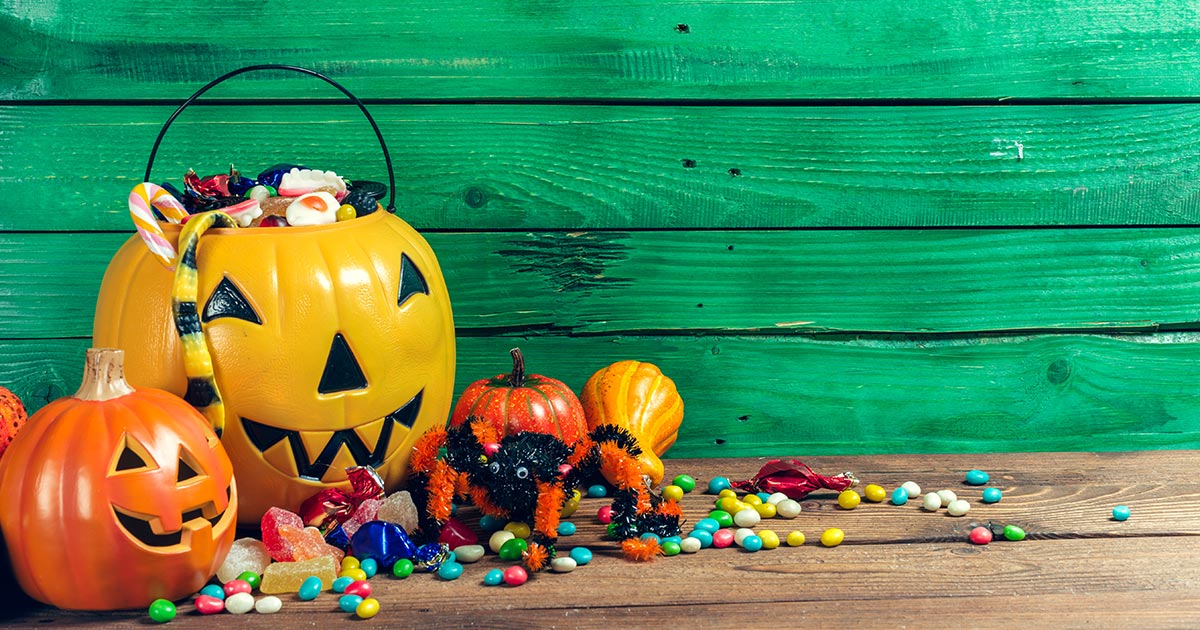Halloween is almost here, and we all know what that means: candy! While enjoying treats in moderation is part of the fun, when it comes to candy and teeth, some options are more forgiving than others.
In this post, we’ll share insights on how sugar affects your teeth and what foods cause cavities before ranking 10 popular Halloween candies based on their impact on oral health. This will help you navigate the spooky season with your stunning smile intact.
Sugar and Teeth: The Basics
As a kid, you might have heard that eating too much sugar causes rotten teeth. The truth is that it’s a little more nuanced than that. Here’s how cavities form:
- The bacteria in your mouth feed on carbohydrates – both sugars and starches. As soon as you eat, whether it’s a piece of bread or a piece of candy, your oral bacteria break it down and, as they do, they release acids.
- The acids leach minerals from your enamel. This is called demineralization.
About 30 minutes after your last sip or bite, the pH in your mouth returns to normal and the remineralization process kicks off, which is when your saliva deposits minerals back into the enamel. - When demineralization happens more often than remineralization, the enamel erodes. Eventually, a hole, called a cavity, forms in the tooth that needs to be repaired by your dentist.
So what foods cause cavities? All carbohydrates?
While all carbohydrates have the potential to cause cavities without proper brushing and flossing, they’re not created equal. Here are the other factors that influence a food’s cavity-causing potential:
- How long the food or drink stays in the mouth;
- The amount and type of sugars/carbohydrates in the food and how easily they’re broken down by oral bacteria;
- Its acidity;
- Whether it contains protective ingredients (i.e., vitamins and minerals that impart a health benefit and/or help to negate acid production).
Candy tends to check a lot of the boxes above. For example, let’s look at why a lemon-flavored lollipop would be considered a food that causes cavities:
- You suck on it, and it dissolves slowly, so your teeth are continually bathed in the sugar. If you crunch it at the end, it will end up lodged in your molars too.
- It’s likely high in refined, white sugar, which oral bacteria love and break down easily.
- The lemon adds acidity, further reducing the pH in your mouth and hastening enamel erosion.
- It has little to no health benefits.
Candy and Teeth: How Popular Types of Halloween Candy Rank
The Good, the Bad and the Sticky
1. Hershey’s Dark Chocolate (or any dark chocolate that’s 70% cocoa) – Best Option for Teeth
Dark chocolate is the unexpected hero of the candy world. With its higher fat content and lower sugar levels compared to milk chocolate, the interaction between its sugar and your teeth is less destructive. Dark chocolate melts quickly in your mouth and is easily washed away with saliva, minimizing the amount of time it hangs out in your mouth.
Aside from the fat, which helps to slow down the acid production process, dark chocolate also has some health-promoting compounds and antibacterial properties. One study published in the International Journal of Oral and Craniofacial Science found eating a small amount of dark chocolate may reduce the number of harmful bacteria in the mouth after a meal.
Oral Health Impact:
- Why it’s better: It has less sugar, more fat and melts easily.
- Tip: If you’re indulging in chocolate, go dark!
2. Aero Milk Chocolate Bar – The Runner-Up
Aero Bars aren’t as damaging as sticky candies because the chocolate melts in the mouth and washes away easily. That said, its higher sugar content compared to dark chocolate makes it the less tooth-friendly of the two options.
Oral Health Impact:
- Why it’s better: The chocolate melts in your mouth.
- Tip: Wash it down with water and brush your teeth after eating it.
3. Reese’s Peanut Butter Cups – Pretty Good Option
Reese’s are soft and melt in your mouth fairly quickly. Swishing with some water or brushing after eating peanut butter cups gets rid of any lingering sugar. Plus, peanut butter adds protein and fat, which makes oral bacteria work harder and process the sugar more slowly.
Oral Health Impact:
- Why it’s better: Reese’s Peanut Butter Cups are low on stickiness and balanced with fat and protein.
- Tip: It’s still sweet, so moderation is key.
4. Smarties – A Quick Melt but Still Sugary
These bright little buttons melt in your mouth, reducing the amount of time your teeth are exposed to the sugar and resulting acids. The addition of the candy shell adds more simple sugar to the mix when compared to plain chocolate. While better than sticky candy, moderation is important.
Oral Health Impact:
- Why it’s better: Smarties melt quickly, limiting exposure time.
- Tip: The sugary shell still fuels bacteria, so rinse with water after enjoying.
5. Kit Kat Bars – Not the Worst but Not the Best
Kit Kats break apart easily, and their wafer structure means they don’t stick too much to teeth. However, they contain refined sugars, which feed cavity-causing bacteria.
Oral Health Impact:
- Why it’s moderate: Kit Kats are easy to eat quickly and have minimal stickiness.
- Tip: Follow with water to rinse off sugars.
6. Coffee Crisp Bars – A Close Match to Kit Kats
Coffee Crisps are similar to Kit Kats with their light, crispy wafer structure. The only reason they fall a place below is because of the addition of the coffee cream, which adds more sugar and ingredients.
When it comes to oral and overall health, simpler is better. The good news? Coffee Crisps still melt quickly and don’t stick to your teeth as much as other candies, making them a better choice than sticky or chewy treats.
Oral Health Impact:
- Why it’s moderate: Coffee Crisps have minimal stickiness, but the added cream makes it slightly riskier.
- Tip: Enjoy with water to rinse off sugars.
7. Snickers – Decent but Sticky
While Snickers bars offer some benefits thanks to the protein from peanuts, their caramel and nougat layers are sticky, allowing the candy to stick to your teeth longer.
Oral Health Impact:
- Why it’s risky: Sticky caramel = longer sugar exposure.
- Suggestion: Brush your teeth after eating!
8. Swedish Fish – Sticky and Sweet
These sweet fish are popular but notoriously sticky. They stick to teeth and are hard to wash away, which makes them a perfect breeding ground for cavity-causing bacteria.
Oral Health Impact:
- Why it’s risky: The candy lingers on teeth for too long.
- Suggestion: Rinse your mouth out well after eating.
9. Starburst – Trouble in Chewy Form
Starburst are small, fruity and fun—but they’re also sticky, slightly acidic and prone to getting stuck in the pits and grooves of the back teeth, providing plenty of fodder for bacteria and prolonging acid attacks. Super chewy candy like Starburst also poses a risk to dental restorations such as fillings.
Oral Health Impact:
- Why it’s harmful: Starburst are extremely sticky and high in sugar.
- Tip: Eat quickly and rinse with water. Because of the acidity, wait at least 30 minutes after indulging to brush your teeth.
10. Sour Patch Kids – Double Trouble
Why are Sour Patch Kids at the bottom of our Halloween candy rank? Because when it comes to candy and teeth, sour candies are a two-in-one threat: they contain sugar, and their acidity lowers the mouth’s pH, making enamel more prone to erosion. Sour Patch Kids are coated in both regular sugar and a special sour sugar, which contains a mix of citric and tartaric acids. As you can guess, this can wreak havoc on your teeth.
Oral Health Impact:
- Why it’s harmful: Acid + sugar = major cavity risk.
- Tip: Eat these rarely and rinse with water afterward. Wait 30 minutes to brush your teeth after enjoying.
Bonus Tips for a Smile-Friendly Halloween
Follow these tricks when having your Halloween treats. Here’s how to enjoy both candy and teeth that are cavity-free:
- Choose candy that melts quickly (like dark chocolate) over sticky or chewy options.
- Drink water after eating candy to wash away sugars, stimulate saliva production and help your mouth return to its normal pH.
- Limit grazing on candy throughout the day – one sitting, preferably as part of a larger meal, is better than frequent snacking.
- Brush your teeth after indulging. But if you have something acidic like Sour Patch Kids, wait at least 30 minutes before brushing.
- Floss before bed. This will ensure you remove any stuck candy from areas your toothbrush can’t reach.
Candy and Teeth: The Bottom Line
As long as you’re eating a balanced diet, brushing and flossing regularly, and keeping up with routine dental exams and cleanings, what you eat on Halloween shouldn’t have much of an impact on your oral health.
If you want to be cautious about candy and teeth, stick to treats that melt in the mouth and aren’t overly sticky, such as dark chocolate or Reese’s Peanut Butter Cups. Rinse with water after eating and brush and floss when you get home.
Book an Appointment With a Vancouver Dentist This Fall
Happy Halloween from the Nest Dental team. Whether you find your teeth hurt when eating candy or you’re just ready to keep your smile healthy this fall, schedule an exam at our Fraser Street dental studio today!




